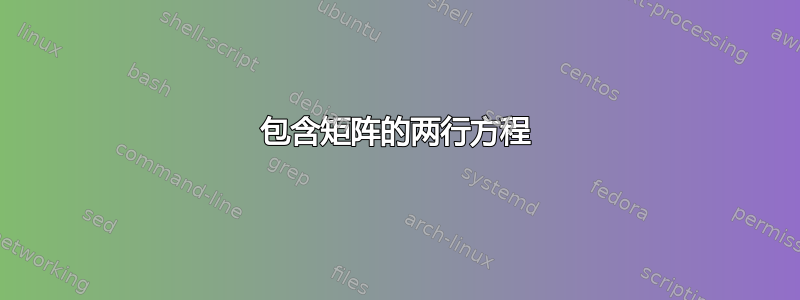
我想得到一个两行方程,其中一行由变量和矩阵组成。我试过 {align} 和 {matrix},但没有用。
\begin{equation}
\label{eqk27}
\begin{align}
\bm{\mathrm{w}}^\mathrm{T} \bm{X}^\mathrm{T} & = [w_1, \hspace{0.1cm} w_2, \hspace{0.1cm} cdots, \hspace{0.1cm} w_n]
\left[
\begin{matrix}
x_{1,1} & x_{2,1} & \cdots & x_{n,1} \\
x_{1,2} & x_{2,2} & \cdots & x_{n,2} \\
\vdots & \vdots & \vdots & \vdots \\
x_{1,n} & x_{2,n} & \cdots & x_{n,n}
\end{matrix}
\right] \\
& = [\sum_{i=1}^{} w_i x_{1,i}, \hspace{0.1cm} \sum_{i=1}^{} w_i x_{2,i}, \hspace{0.1cm} \cdots, \hspace{0.1cm} \sum_{i=1}^{} w_i x_{2,i} ]
\end{align}
\end{equation}
答案1
您不能align在 内嵌套equation。下面是带有 的版本aligned。代码需要改进,但不清楚您想用 、 等获得\bm什么\hspace。
\documentclass{article}
\usepackage{amsmath,amssymb}
\def\bm{}
\begin{document}
\begin{equation}
\label{eqk27}
\begin{aligned}
\bm{\mathrm{w}}^\mathrm{T} \bm{X}^\mathrm{T} & = [w_1, \hspace{0.1cm} w_2, \hspace{0.1cm} \cdots, \hspace{0.1cm} w_n]
\left[
\begin{matrix}
x_{1,1} & x_{2,1} & \cdots & x_{n,1} \\
x_{1,2} & x_{2,2} & \cdots & x_{n,2} \\
\vdots & \vdots & \vdots & \vdots \\
x_{1,n} & x_{2,n} & \cdots & x_{n,n}
\end{matrix}
\right] \\
%
& = [\sum_{i=1}^{} w_i x_{1,i}, \hspace{0.1cm} \sum_{i=1}^{} w_i x_{2,i}, \hspace{0.1cm} \cdots, \hspace{0.1cm} \sum_{i=1}^{} w_i x_{2,i} ]
\end{aligned}
\end{equation}
\end{document}
答案2
我相信你想要split(当然不是align不能嵌套的equation)。
您还希望
- 表示转置的宏,
- 用于表示(列)向量的宏,以及
- 表示矩阵的宏
这样可以避免大量标记,同时只需修改定义就可以改变整个符号。
\documentclass{article}
\usepackage{amsmath}
\usepackage{bm}
\newcommand{\TP}{{\mathrm{T}}} % transpose
\newcommand{\vect}[1]{\mathbf{#1}}
\newcommand{\matr}[1]{\bm{#1}} % matrix
\begin{document}
\begin{equation}\label{eqk27}
\begin{split}
\vect{w}^\TP \matr{X}^\TP
& = \begin{bmatrix} w_1 & w_2 & \dots & w_n \end{bmatrix}
\begin{bmatrix}
x_{1,1} & x_{2,1} & \dots & x_{n,1} \\
x_{1,2} & x_{2,2} & \dots & x_{n,2} \\
\vdots & \vdots & \vdots & \vdots \\
x_{1,n} & x_{2,n} & \dots & x_{n,n}
\end{bmatrix}
\\[1ex]
& = \begin{bmatrix}
\sum\limits_{i=1}^{n} w_i x_{1,i} &
\sum\limits_{i=1}^{n} w_i x_{2,i} &
\dots &
\sum\limits_{i=1}^{n} w_i x_{2,i}
\end{bmatrix}
\end{split}
\end{equation}
\end{document}
答案3
不要将matrix环境放在构造内部\left\[ ... \right],而只需使用bmatrix环境;binbmatrix代表“方形b球拍”。其次,由于行向量在数学上也是矩阵,并且它们被括在方括号中,因此bmatrix也只需对它们使用环境即可。(附言:对行向量使用环境的一个优点bmatrix是您不必关心方括号的大小。)第三,\bm{\mathrm{w}}可以更简单地表述为\mathbf{w}。
最后但并非最不重要的一点是,您应该使用aligned或split环境来 (a) 将完整表达式拆分为两行并 (b) 将=符号上的方程片段对齐。split环境将方程编号垂直居中,而环境允许您选择将方程编号放在顶行或底行。和环境aligned生成的输出显示在以下屏幕截图中。alignedsplit
\documentclass{article}
\usepackage{amsmath} % for 'aligned', 'split', and 'bmatrix' environments
\begin{document}
\noindent
with \texttt{aligned} environment
\begin{equation}\label{eqk27aligned}
\begin{aligned}[b]
\mathbf{w}^\mathrm{T} \mathbf{X}^\mathrm{T}
%
&= \begin{bmatrix}
w_1 & w_2 & \dots & w_n
\end{bmatrix}
\begin{bmatrix}
x_{11} & x_{21} & \dots & x_{n1} \\
x_{12} & x_{22} & \dots & x_{n2} \\
\vdots & \vdots & \ddots& \vdots \\
x_{1n} & x_{2n} & \dots & x_{nn}
\end{bmatrix} \\[\jot]
%
&= \begin{bmatrix} \,
\sum_{i=1}^{n} w_i x_{1i} &
\sum_{i=1}^{n} w_i x_{2i} &
\dots &
\sum_{i=1}^{n} w_i x_{ni}
\end{bmatrix}
\end{aligned}
\end{equation}
\bigskip\noindent
with \texttt{split} environment
\begin{equation}\label{eqk27split}
\begin{split}
\mathbf{w}^\mathrm{T} \mathbf{X}^\mathrm{T}
%
&= \begin{bmatrix}
w_1 & w_2 & \dots & w_n
\end{bmatrix}
\begin{bmatrix}
x_{11} & x_{21} & \dots & x_{n1} \\
x_{12} & x_{22} & \dots & x_{n2} \\
\vdots & \vdots & \ddots& \vdots \\
x_{1n} & x_{2n} & \dots & x_{nn}
\end{bmatrix} \\[\jot]
%
&= \begin{bmatrix} \,
\sum_{i=1}^{n} w_i x_{1i} &
\sum_{i=1}^{n} w_i x_{2i} &
\dots &
\sum_{i=1}^{n} w_i x_{ni}
\end{bmatrix}
\end{split}
\end{equation}
\end{document}





